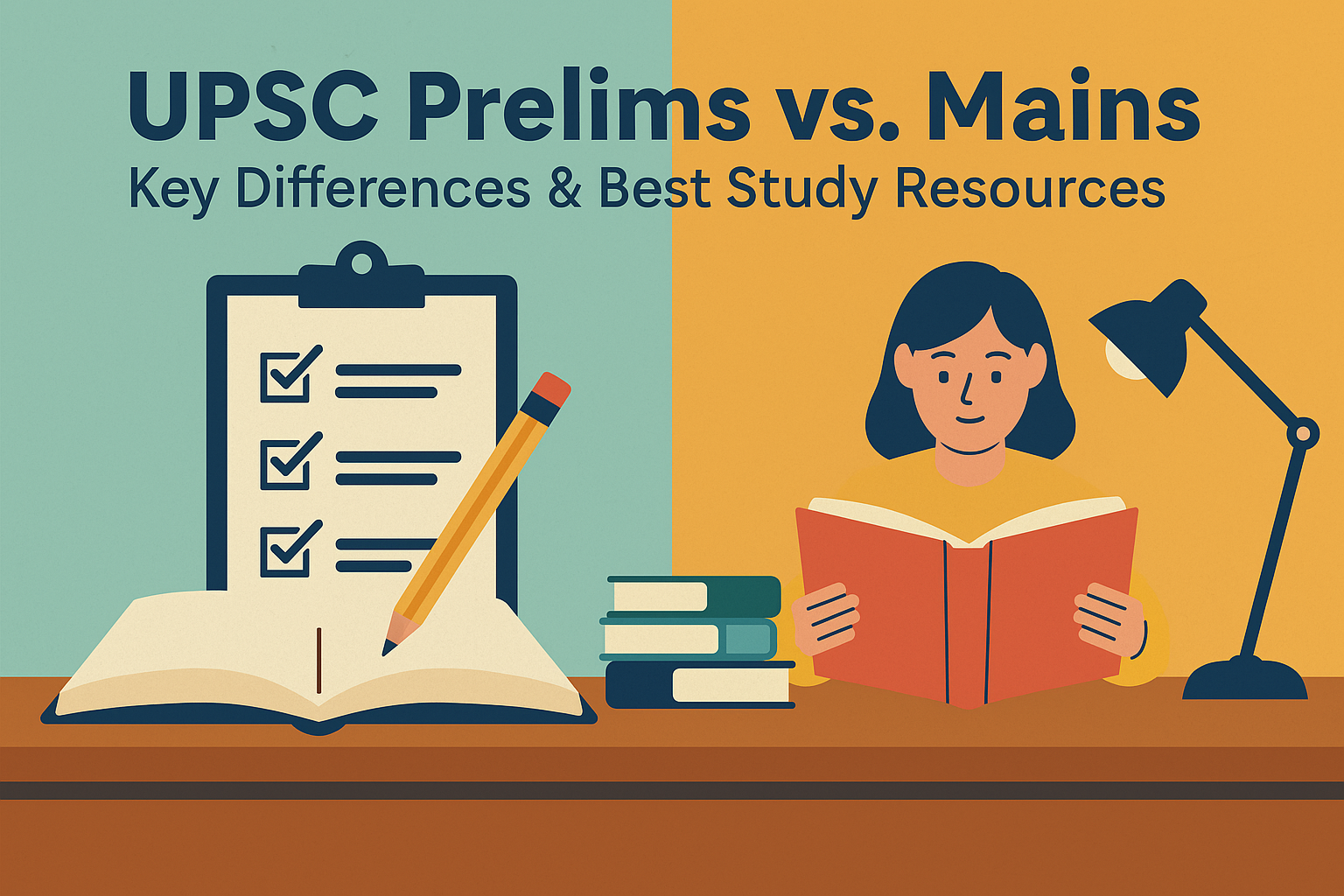The Union Public Service Commission (UPSC) Civil Services Examination is not just another competitive exam- it is a gateway to India’s most prestigious careers, including the Indian Administrative Service (IAS), Indian Police Service (IPS), Indian Foreign Service (IFS), and many other coveted posts that shape the governance of the nation. Every year, lakhs of aspirants across India embark on this rigorous journey with one goal: to serve the country and bring about real change. But before dreams can be realized, understanding the very structure of this examination is crucial.
The UPSC CSE is conducted in three distinct phases- Prelims, Mains, and the Personality Test (Interview) – each designed to test different facets of an aspirant’s knowledge, aptitude, and personality. However, it is the Prelims and Mains stages that require strategically different approaches, both in terms of preparation and mindset. While the Prelims are all about speed, accuracy, and broad factual awareness, the Mains exam focuses on depth, articulation, critical thinking, and structured expression. Therefore, a clear understanding of how these two stages differ is fundamental to crafting an efficient preparation strategy.
Many first-time aspirants make the mistake of preparing for both stages in the same way and relying on random resources without knowing what each phase truly demands. The truth is you need to prepare differently for each phase, while also understanding how both stages are interconnected. And that’s where smart resources come into play.
In this blog, we’ll break down the major differences between the Prelims and Mains in a simple yet comprehensive table format to help you visualize the contrast more clearly. Following that, we’ll walk you through three powerful books from GK Publications– each tailored to suit the needs of different stages of the UPSC exam. From crisp NCERT summaries from Prelims, to complete CSAT preparation, and a detailed collection of past Essay Papers for Mains, these books are the kind of companions every serious aspirants needs.
So, whether you’re a beginner trying to decode the exam or a repeat candidate looking to refine your strategy, this guide will help you navigate the two most crucial stages of the UPSC exam—and empower you with the right resources to study smarter, not just harder.
Let’s get started with the core comparison: Prelims vs. Mains—how they differ, and how you can master them both.
UPSC Prelims vs. Mains: A Comparative Overview
| Criteria | Prelims | Mains |
| Purpose | Screening test | Merit-based final selection |
| Type of Questions | Objective (MCQs) | Descriptive (essay-type) |
| Papers | Two – General Studies I & CSAT | Nine – Essay, 4 GS papers, 2 optional papers, 2 language papers |
| Syllabus Coverage | Broad and factual, mostly based on NCERTs and current affairs | Analytical and in-depth, with critical evaluation and presentation |
| Qualifying Marks | CSAT is qualifying (33%); GS marks used for shortlisting | All papers (except language) count toward merit |
| Duration | 2 hours for each paper | 3 hours for each paper |
| Evaluation Method | OMR sheet-based marking | Manual evaluation by subject experts |
| Negative Marking | Yes (1/3rd of the mark deducted for incorrect answers) | No negative marking |
| Focus Area | Speed, accuracy, and factual knowledge | Depth, articulation, analysis, and structured writing |
Top Study Resources by GK Publications for UPSC 2025
To assist aspirants in mastering both Prelims and Mains, GK Publications offers a range of expert-curated books aligned with the latest exam pattern. Below are three top resources that have been widely recommended for their content clarity, structure, and exam relevance.
A strong grasp of NCERT textbooks is often considered the backbone of UPSC preparation. However, reading all 40+ NCERT books can be time-consuming. This is where GK Publications’ NCERT Summary Set becomes an invaluable asset.
This 6-book set compiles and summarizes content from Class 6 to 12 NCERTs, covering:
- Indian Society
- General Science
- Indian Economy
- Indian Polity
- Indian & World Geography
- Indian History
Key Features:
- Over 40 NCERT books condensed into a set of 6 core subjects.
- 1,100+ chapter-wise MCQs for topic-wise self-assessment
- Infographics, charts, and maps to aid visual learning
- Precise and crisp explanations ideal for quick revision
- Covers all essential areas needed for Prelims and early Mains prep
This set is ideal not only for UPSC IAS, but also for State PSC, EPFO, CAPF AC, and other competitive exams. Aspirants who struggle with managing vast content will find this set particularly useful for revising core concepts quickly and effectively.
Though CSAT is a qualifying paper in Prelims, many aspirants find it challenging due to its analytical nature. GK Publications’ CSAT Set is designed to help aspirants gain mastery in every component of Paper-II.
This complete 6-book set includes:
- How to Tackle Quantitative Aptitude for CSAT
- How to Tackle General Mental Ability & Logical Reasoning for CSAT
- How to Tackle Reading Comprehension & Verbal Logic for CSAT
- Practice Tests – Quantitative Aptitude & Data Sufficiency
- Practice Tests – General Mental Ability & Logical Reasoning
- Practice Tests – Reading Comprehension, Verbal Logic & Decision Making
Key Highlights:
- Three conceptual guides with solved examples and learning strategies
- Three practice test books simulating real exam experience
- Includes shortcuts, tricks, and time-saving techniques
- Provides a step-by-step strategy to master each section with confidence
Whether you’re struggling with data interpretation or verbal reasoning, this set offers comprehensive support to ensure you comfortably clear the CSAT cutoff.
The Essay Paper in Mains carries 250 marks and often plays a decisive role in the final merit. GK Publications’ Essay Book by DVK Rao is a treasure trove for essay preparation, offering aspirants a real sense of past trends and writing formats.
What this book includes:
- 116 essays from past UPSC exams starting from 1993 onwards
- Essays arranged topic-wise for structured practice
- Each essay follows the 1000–1200 word limit, aligned with UPSC standards
- Includes strategies and tips on structuring your essay, forming arguments, and writing impactful conclusions
From social issues and governance to philosophical and abstract topics, this book provides a broad canvas of themes that often appear in the Essay Paper. Practicing with this book not only improves content delivery but also builds the necessary skill of coherent thought flow and articulation.
Final Thoughts: Strategize with the Right Resources
Cracking the UPSC exam requires more than just hard work—it demands a smart and structured approach. Understanding the clear differences between Prelims and Mains helps aspirants tailor their preparation accordingly. While Prelims needs rapid revision, conceptual clarity, and regular practice of MCQs, the Mains exam requires critical analysis, structured writing, and strong articulation.
This is where high-quality resources like the GK Publications UPSC 2025 series come into play. Whether it’s condensing your NCERT preparation, mastering CSAT with confidence, or writing compelling essays for Mains, these books have you covered at every step.
Invest in the right material, stay consistent, and align your preparation with the demands of each stage of the exam. With dedication and the right strategy, your dream of becoming a civil servant is well within reach.








